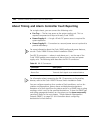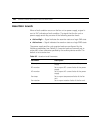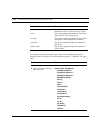
ADC Telecommunications, Inc.
148 C
HAPTER 8: TIMING AND ALARM CONTROLLER MANAGEMENT
About Timing and Alarm Controller Fault Reporting
For a single chassis, you can connect the following units:
■ Fan Tray — The fan tray serves as the system cooling unit. This is a
required component and ships with every Cuda 12000.
■ Power Supply A — A single -48 volt DC power source is required for
system operation.
■ Power Supply B — Connection to a second power source is optional to
provide redundancy.
For more information about the Cuda 12000 cooling and power features,
see the “Cuda 12000 IP Access Switch Installation Guide.”
Two DB-15 connectors — alarms in and alarms out — on the rear of the
Cuda 12000 enable communication of alarms from fan trap and power
supply units. The following table describes the DB-15 connectors:
Table 8-1 DB-15 Connectors
For information about connecting the DB-15 connectors to the auxiliary
devices, refer to the Cuda 12000 IP Access Switch Installation Guide.
You can configure reporting for a number of fault conditions, such as fan
rotation and temperature, power alarms and backplane temperature.
Reception of a fault signal from the device results in an SNMP trap or syslog
message, which is sent to the specified destinations. To view the SNMP trap
and syslog message destinations on the system use the
show snmp notify
command. (Refer to the next chapter, “Simple Network Management
Protocol (SNMP)” on page 161 for information about configuring
destinations for fault events.)
Connector Description
Alarms In Receives fault signals from the connected units.
Alarms Out Transmits fault signals to an external device.


















